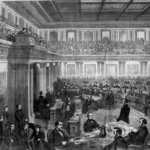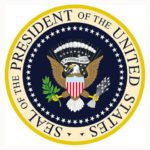From the colonial era, relations between European settlers and Native American nations have been complicated. In 1803 Congress authorized and funded an expedition led by Meriwether Lewis and William Clark for exploration of the region and for better knowledge about American Indians of the Northwest in order to develop trade. About 30 years later, the United States forced the removal of Native Americans from their lands to make way for white American settlement. Congress and the president made treaties with Native American nations, but those treaties were not always respected as the United States continued to expand into the west. After Native Americans enlisted and served in both World War I and World War II, Congress passed legislation to begin to address longstanding Native Americans claims against the United States Government.
The Electoral College
Today, the American people vote for president and vice president on Election Day. But, technically speaking, these votes don’t directly determine the outcome of the election. These popular votes determine which electors will be appointed to the Electoral College, which is made up of 538 electors drawn from the states and the District of Columbia. Each state is granted a different number of electoral votes based on the size of its congressional delegation. The electors meet after the general election to cast their votes for president and vice president.
Presidential Inaugurations, Past and Present
Every four years, on the steps of the U.S. Capitol building, the newly-elected President of the United States is inaugurated. This event not only includes the president taking the oath of office, but also provides the opportunity for the new President to lay out the direction he hopes to take the country. By analyzing historic texts and visuals, students can find common themes as well as important differences when comparing different inaugurations.
The Appointment of Sandra Day O’Connor
The U.S. Constitution grants the President the power to appoint people to a variety of government positions. These appointments require careful thought and consideration since the people can have a great impact on the lives of many Americans during that President’s term. Some appointments need even greater thought and consideration, and those are to the federal judicial system and more importantly, to the Supreme Court of the United States. Justices of the Supreme Court (and other federal courts) serve lifetime appointments. Their rulings as they interpret the Constitution, and other situations as outlined in Article III of the Constitution, can have far-reaching effects for generations. With this awesome power to appoint comes an equally awesome responsibility to make sure that the individuals are the best people for the job. In this lesson, students will examine the appointment of Supreme Court Justice Sandra Day O’Connor, who was also the first female Justice. Students will examine the process by which a President makes the selection and the steps that lead to that person being confirmed by the Senate (or not).
Letters to the President (Elementary)
In this lesson, students will learn both to be informed and to be engaged as they learn about an issue that is important to them, and communicate their thoughts on the issue to the President of the United States.
Letters to the President (Secondary)
In this lesson, students will learn both to be informed and to be engaged as they learn about an issue that is important to them, and communicate their thoughts on the issue to the President of the United States.
Election: The Road to the White House (Secondary)
During an election, civic energy reaches a fever pitch. The vote is one of the citizen’s most powerful tools, and advocating for a candidate, a set of ideas, or a platform is the right of every citizen. The President of the United States is often called the most powerful person in the world, so with every presidential election, the stakes are high. This unit is designed to teach students about presidential elections. It is not a collection of facts, diagrams, and explanations of processes. It is an interactive, project-based unit that invites the student to fully engage in the process of an election while also informing students about how elections work. It is our hope that this unit helps cultivate the sorts of informed and engaged citizens that are so essential to our democracy.
Constitutional Crisis and Impeachment: Lesson Plans and Activities

Historically, the United States House has only impeached two presidents, Andrew Johnson and Bill Clinton. However, neither president ended up being removed from office by the Senate. Share My Lesson has curated this collection of free lesson plans and resources to support educators in teaching students about what impeachment means, the history of impeachment, and how the impeachment process works.
The President’s Roles and Responsibilities: Communicating with the President

In order to become informed participants in a democracy, students must learn about the women and men who make decisions concerning their lives, their country, and the world. The president of the United States is one such leader. As a nation, we place no greater responsibility on any one individual than we do on the president. Through several activites, students learn about the roles and responsibilities of the U.S. president and their own roles as citizens of a democracy.
Women’s History in the United States
International Women’s Day has been commemorated across the world on March 8th since 1911 and every U.S. President has marked March as Women’s History Month since 1995. While the right to vote is a common topic of study in classrooms when examining women’s history, there are many more issues, perspectives, and accomplishments that require investigation across history, literature, and the arts to more fully appreciate and understand what women’s history in the U.S. encompasses. Our Teacher’s Guide provides compelling questions, lesson activities, resources for teaching about the intersection of place and history, and multimedia resources to integrate women’s perspectives and experiences throughout the school year.